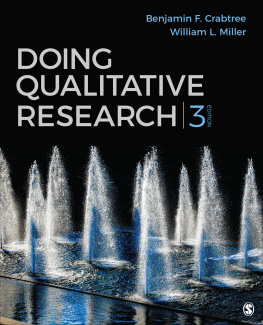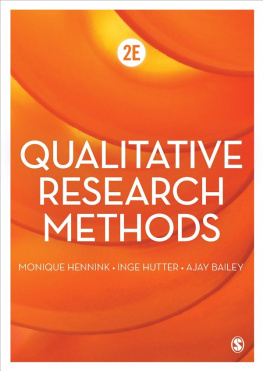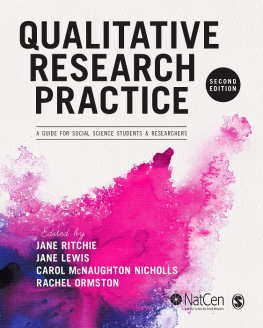Sarah J. Tracy - Qualitative Research Methods: Collecting Evidence, Crafting Analysis, Communicating Impact
Here you can read online Sarah J. Tracy - Qualitative Research Methods: Collecting Evidence, Crafting Analysis, Communicating Impact full text of the book (entire story) in english for free. Download pdf and epub, get meaning, cover and reviews about this ebook. year: 2019, publisher: Wiley-Blackwell, genre: Politics. Description of the work, (preface) as well as reviews are available. Best literature library LitArk.com created for fans of good reading and offers a wide selection of genres:
Romance novel
Science fiction
Adventure
Detective
Science
History
Home and family
Prose
Art
Politics
Computer
Non-fiction
Religion
Business
Children
Humor
Choose a favorite category and find really read worthwhile books. Enjoy immersion in the world of imagination, feel the emotions of the characters or learn something new for yourself, make an fascinating discovery.

- Book:Qualitative Research Methods: Collecting Evidence, Crafting Analysis, Communicating Impact
- Author:
- Publisher:Wiley-Blackwell
- Genre:
- Year:2019
- Rating:5 / 5
- Favourites:Add to favourites
- Your mark:
Qualitative Research Methods: Collecting Evidence, Crafting Analysis, Communicating Impact: summary, description and annotation
We offer to read an annotation, description, summary or preface (depends on what the author of the book "Qualitative Research Methods: Collecting Evidence, Crafting Analysis, Communicating Impact" wrote himself). If you haven't found the necessary information about the book — write in the comments, we will try to find it.
Qualitative Research Methods: Collecting Evidence, Crafting Analysis, Communicating Impact is a comprehensive guide on both the theoretical foundations and practical application of qualitative methodology. Adopting a phronetic-iterative approach, this foundational book leads readers through the chronological progression of a qualitative research project, from designing a study and collecting and analyzing data to developing theories and effectively communicating the results--allowing readers to employ qualitative methods in their projects as they follow each chapter.
Coverage of topics such as qualitative theories, ethics, sampling, interview techniques, qualitative quality, and advice on practical fieldwork provides clear and concise guidance on how to design and conduct sound research projects. Easy-to-follow instructions on iterative qualitative data analysis explain how to organize, code, interpret, make claims, and build theory. Throughout, the author offers her own backstage stories about fieldwork, analysis, drafting, writing, and publishing, revealing the emotional and humorous aspects of practicing qualitative methods.
Now in its second edition, this thorough and informative text includes new and expanded sections on topics including post-qualitative research, phenomenology, textual analysis and cultural studies, gaining access to elite and difficult to access populations, on persuasive writing, novel interviewing approaches, and more. Numerous examples, case studies, activities, and discussion questions have been updated to reflect current research and ensure contemporary relevance.
Written in an engaging and accessible narrative style by an acclaimed scholar and researcher in the field Offers new and updated examples of coding and qualitative analysis, full-color photos and illustrations, and a companion instructor website Synthesizes the most up-to-date multidisciplinary literature on qualitative research methods including seven main approaches to qualitative inquiry: grounded theory, case study, ethnography, phenomenology, narrative and autoethnography, participatory action research, and arts-based research Presents innovative qualitative data collection methods and modern representation strategies, such as virtual ethnography, photo-voice, and mobile interviewing Qualitative Research Methods: Collecting Evidence, Crafting Analysis, Communicating Impact is an ideal resource for undergraduate and graduate students, instructors, and faculty across multiple disciplines including the social sciences, healthcare, education, management, and the humanities, and for practitioners seeking expert guidance on practical qualitative methods.
Sarah J. Tracy: author's other books
Who wrote Qualitative Research Methods: Collecting Evidence, Crafting Analysis, Communicating Impact? Find out the surname, the name of the author of the book and a list of all author's works by series.










